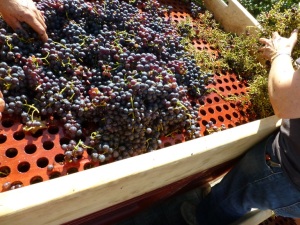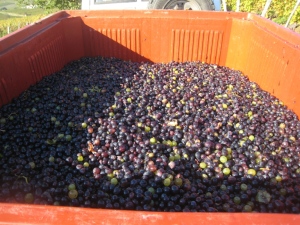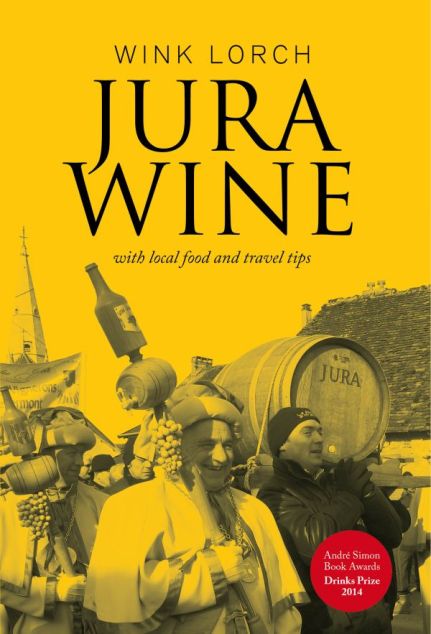The month of May saw the sad death of two Jura vignerons, who were hugely important figures both locally and internationally. Pascal Clairet, who ran Domaine de la Tournelle with his wife Evelyne, ended his life aged just 58 on 5th May. Lucien Aviet (known as Bacchus) of Caveau de Bacchus died on 28th May, aged almost 84.

Firstly, I would like to extend my heartfelt sympathies to their families and friends. I know that all who have enjoyed their wines over the years, or indeed met these two extraordinary characters on visits to the Jura wine region, will be touched by these losses, as is everyone in the region, or connected with the Jura wine world, to whom they gave so much of their time.
I am personally grateful to both Pascal and Bacchus not only for the wines they crafted – Pascal together with Evelyne, and Bacchus with his son Vincent – but also for what they taught me about the terroirs, grapes and winemaking in the Jura. Both men showed single-minded purpose in the way they chose to bring the Jura terroir to life in their wines.
Although both made highly characterful Chardonnays that reflected their terroir well (interestingly neither vigneron ever made a Pinot Noir as far as I am aware), it was their handling of the three indigenous Jura grape varieties, Savagnin, Poulsard and Trousseau that to me provided the star wines in their ranges.
Their profiles in my book, Jura Wine, were written more than seven years ago but still reflect well these fine Jura estates, which had both very much made their mark on the region by that time. The main photos that feature in this post, kindly provided by Mick Rock of Cephas, chief photographer for the book, were taken exactly eight years ago in the early summer of 2013, one that was slow to kick in, not so dissimilar to 2021.
Lucien Aviet: 1937-2021
Born into a farming family, Lucien Aviet made wine full-time from 1960 having returned from fighting for France in the Algerian War. He was one of the first vignerons to bottle his own wine from the vineyards he built up in and around his village of Montigny-les-Arsures.
Of a similar age, Lucien knew Pierre Overnoy well and although many of their vineyard and winemaking methods were different, like Pierre he remained adamant that indigenous yeasts were essential to making good wine. The two of them were the vignerons represented at the famous tasting of the 1774 Arbois ‘vin jaune’ in 1994. Lucien said the experience of tasting a 200-year old wine gave him goose-bumps.
He was an emotional, dedicated man, who for this English woman, took time to get to know. But I felt I knew him enough to write this in my book:
“Much respected locally, Bacchus seems like one of those dyed-in-the-wool traditionalists who believes there’s only one way to do things, yet he presents his opinions almost as a challenge, always accompanied by a mischievous twinkle in his blue eyes. And there is nothing Lucien enjoys more than pouring his wines and sharing laughter and banter around the stove in their old cellars, full of foudres adorned with cartoons and bons mots.” The official notice of his death posted by his family asked that according to his wishes, everyone should raise a glass to celebrate his life.
He was and remains a hard act for his son Vincent to follow, but the latter’s wines are going from strength to strength in quality, still aged in their beautifully maintained Alsace foudres among other oak barrels. Whereas there are wonderful traditional Savagnins and Vins Jaunes, and some fascinating Chardonnays (Cuvée des Docteurs after the medical students who helped Lucien with his first harvest), it is their Trousseau cuvées, named by Lucien Cuvée des Géologues in homage to the geologists who helped him select the best terroirs, that have been among the most wonderful expressions of this grape variety. The great character of Bacchus will always be remembered in the name of their winery, Caveau de Bacchus.
Pascal Clairet: 1962-2021
Pascal was from Montmalin, a vineyard village close to Arbois, but his family were not vignerons; wine became Pascal’s chosen career beginning as a wine technician. He founded Domaine de la Tournelle in 1991, and was running it full-time from 1995, taking on the cellars in Arbois, to be joined a couple of years later by Evelyne.
My earliest memories of meeting Pascal was as part of the press group for the Percée du Vin Jaune almost 20 years ago. He had worked for several years earlier as a technologist for the CIVJ. Along with his friend Jean-Michel Petit, the two were considered then as representatives of the younger generation. Pascal was often there to greet and sweet talk the media over dinners, his support for the Jura allied with his openness and frankness did the job perfectly.
When I started to visit the region regularly, Domaine de la Tournelle soon featured on my priority list for visits, and in those early days it was usually Pascal who hosted me, rather than Evelyne as she would be busy with the children. That said, I must stress that they were the earliest true working partnership of man and woman in the Jura wine world that I came across. It is to Pascal’s great credit that he always appeared to treat Evelyne as his equal in their business, especially in winemaking – she was also qualified as an oenologist. Pascal was the one in charge of the vineyards.
Pascal was discreet about the estate’s conversion to organics, then biodynamics and taking the natural route – he was never one to proselytise, more one to question everything. In his early days he had tasted much at the side of Pierre Overnoy, and had evidently learned from him about handling the difficult Poulsard grape. When, after the blisteringly hot and early 2003 vintage, he made his first no-sulphur-added, carbonic maceration cuvée of Poulsard, rebaptised Uva Arbosiana to reflect the old name of the grape, I was surprised and won over by the wine, eager to learn why and how he had done it. The wine remains a favourite (or possibly the favourite) Poulsard of mine, and I adored a bottle of 2018 shared over a meal in Arbois last summer.
Also influenced by Pierre, Domaine de la Tournelle was one of the earliest to make a Savagnin Ouillé from 1994, named Fleur de Savagnin. Its pristine quality shines brightly providing essence of Savagnin, yet the other Savagnins from the domaine including the Vin Jaune are exemplary too. Trousseau from the fabulous Les Corvées vineyard and beautiful terroir Chardonnays show the huge attention to detail, making a natural wine range that reaches the heights of quality you might find in the best made according to any winemaking regime.
Pascal was a proud man, sometimes troubled yes, and he was another vigneron who loved to share the joy of wine with others. This was utterly in evidence on the October day in 2012 when my late partner Brett and I spent the day with the Clairets for harvest, another time when I learned so much, as well as having enormous fun.
Pascal was one of the early creators of the Le Nez dans le Vert group of organic vignerons and had recently taken on the task of being co-president. In normal times the group organises a large tasting in the Jura once a year for public and professionals, and another in Paris for pros only, but also acts as a support group internally. Many of the younger and more recently established vignerons looked up to him as a mentor, so they will feel his loss particularly badly.
I have little direct contact in the region right now, and it is very early days for Evelyne, but she has indicated to me that, while obviously devastated, she will carry on with all that the pair built up together. I wish her all the courage in the world for the task and sincerely hope that I and others will one day be able to toast the memory of Pascal on the beautiful terrace of their little summer Bistrot de la Tournelle, another fine joint creation of this special couple.

A Region that Must Rise to the Challenge
As if these losses were not enough, after a warm month of March this year, April once again delivered debilitating frosts in the vineyards of the Jura as they did elsewhere, causing potential crop losses of up to 50% in some vineyards around Arbois. The losses are still being fully assessed but follow on from bad frosts and low crops for other reasons too in both 2019 and 2017.
Coupled with the complications of Covid halting the important local restaurant trade for so long, not to mention on-site tastings for a period too, the region is struggling to keep a brave face, despite its undoubted continued and growing success on export markets.
I wish all the Jura vignerons the strength to keep on going through all these challenges. We believe in you, your individualistic wines and your fabulous region and thank you for your work and dedication.
Postscript: This is a post about recent events in Arbois, especially. For personal reasons I haven’t been able to write much recently, but it would be remiss of me not to mark also the death of the legendary Château-Chalon vigneron Jean Macle in December 2020, aged 87. He was another man from whom I learned so much. His work is being admirably continued by his son Laurent.











